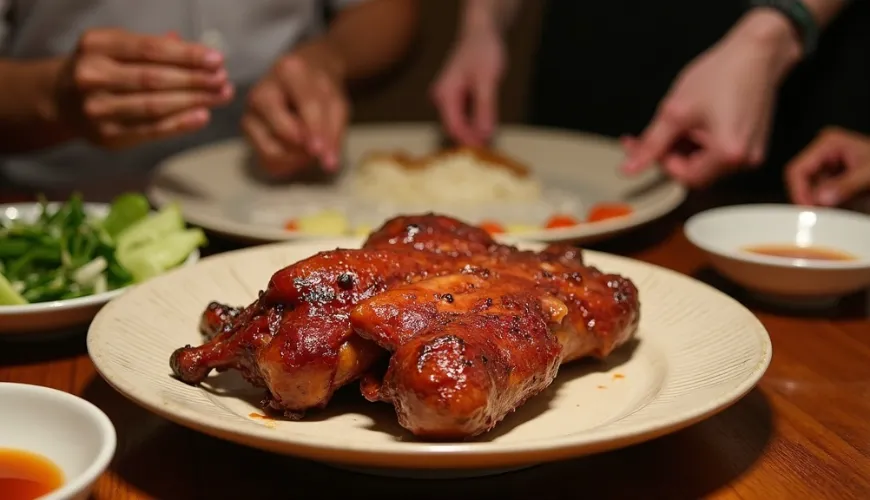
How to Make a Peking Duck Recipe That Will Impress You

The Secret of the Famous Peking Duck - A Masterful Recipe with History and Flavor
If there is one dish that can combine culinary tradition, precision in preparation, and a truly gastronomic experience, it is undoubtedly Peking duck. This Chinese dish, famous worldwide, is not just about flavors – it is a ritual that begins with meticulous preparation and ends with warm sharing at the table. Whether you are trying to prepare it at home or are interested in its cultural significance, you will find everything you need right here.
You might wonder: is it even worth attempting a homemade version of such a famous and sophisticated recipe? The answer is yes – even the recipe for Peking duck can be adapted to home conditions without losing its taste or authenticity. Moreover, it is a culinary challenge that takes you deep into the heart of Chinese cuisine and history.
Originating from the Imperial Kitchen
The roots of the traditional Peking duck recipe date back to the Yuan dynasty (13th century), but it gained its fame during the Ming dynasty. Originally, it was a delicacy served in court kitchens, primarily prepared for the imperial family. Over time, it spread among common people and remains a symbol of luxury, hospitality, and tradition to this day.
The method of preparation has been passed down through generations – not only as a cooking technique but almost as a form of art. In Beijing, there are even restaurants that specialize solely in this dish, with some chefs dedicating their entire lives to its preparation. It's not just about the taste but also the texture, aroma, and perfect presentation.
What Makes Peking Duck Peking?
The foundation is choosing the right duck – ideally, a specially raised duck with tender meat and higher fat content is used. The duck is then portioned, cleaned, and air-dried for several days, which is crucial for achieving the perfect crispy skin. The actual roasting traditionally takes place in a wood-fired oven, where the duck is hung and slowly rotated.
Although the authentic process is demanding and time-consuming, the recipe for Peking duck can be modified for a home oven. The key is proper preparation and patience. The result is a dish with deliciously crispy skin, juicy meat, and an unmistakable flavor that lingers in the mouth long after the last bite.
Step-by-Step Recipe for Homemade Peking Duck
Before you start, keep in mind that the preparation takes at least two days. But it's this slowness and thoroughness that highlights its uniqueness.
Ingredients:
- 1 whole duck (about 2–2.5 kg)
- 2 tablespoons dark soy sauce
- 2 tablespoons light soy sauce
- 1 tablespoon honey
- 1 tablespoon rice vinegar
- 1 teaspoon Chinese five-spice
- 1 tablespoon sesame oil
- Salt to taste
- Hot water for scalding
- Pancakes for serving (or thin wheat wraps)
- Spring onion, cucumber, and hoisin sauce for serving
Method:
- Duck Preparation: Wash the duck with cold water and dry thoroughly. Place it in a large pot and pour hot water over it – this removes excess fat and tightens the skin. Then dry again with paper towels.
- Glaze: Mix the light and dark soy sauce, honey, vinegar, five-spice, and sesame oil. Coat the entire duck with this mixture, ideally also inside.
- Drying: Hang the duck (e.g., using a hook over a bathtub or in a cool pantry) and let it dry for at least 24 hours. If you can't hang it, place it on a rack and leave uncovered in the fridge.
- Roasting: Preheat the oven to 180 °C. Place the duck on a rack in a baking pan to allow the fat to drip off. Roast for about 1.5 to 2 hours, basting it several times with its own juices. In the last 10 minutes, roast at a higher temperature (220 °C) for extra crispy skin.
- Serving: Slice the meat into thin strips, separate the skin, and serve separately. Serve with wraps, spring onions, cucumber, and hoisin sauce.
It's Not Just Food, It's an Experience
Peking duck is rarely enjoyed alone. In China, it is primarily a social event, where family or friends gather at the table to share food and chat. The serving itself is also interesting – the chef often carves the duck right in front of the guests, and everyone receives carefully sliced pieces of meat with crispy skin.
Markéta, who tasted the duck directly in Beijing, recalls a similar experience: "What surprised me the most was how light the duck actually was. I expected fatty meat, but thanks to the preparation, it was tender, fragrant, and not heavy at all. And eating everything with sauce, vegetables, and in wraps was great – I felt like I was at a Chinese feast."
How to Combine Tradition and Sustainability?
In a time when more people are concerned about where their food comes from and its impact on the planet, it is worth considering how to adapt the recipe for Peking duck to modern values. While the dish itself comes from times when sustainability wasn't a topic, today, we can choose more eco-friendly options – such as selecting a duck from organic farming, using organic ingredients, or preparing all side dishes without using prepackaged products.
Many people also try to replicate the flavors of Asian cuisine in a plant-based form. And while nothing can replace authentic duck skin, there are interesting alternatives – such as tofu marinated in hoisin sauce, served in wraps with cucumber and onion, which surprise with their taste and texture.
What to Take Away?
Peking duck is not just a recipe; it is a journey into another world, where history, culture, and true joy of food come together. Whether you decide to prepare it traditionally or adapt it to your lifestyle, one thing is certain: every bite brings you closer to understanding why this dish is so special.
Take your time with the preparation. Allow the aromas, the tenderness of the meat, and the contrast of flavors to shine. And above all—let yourself be enchanted by what ancient Chinese cuisine can do even in the kitchen of a modern apartment.
And if you're interested in the ecological aspect of such a feast, try checking out the selection of organic spices, natural sauces, or zero-waste packaging at the Ferwer e-shop. You might find that even a traditional recipe can be modernly sustainable.

